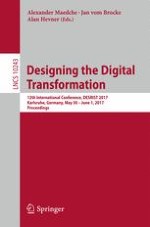
2017 | OriginalPaper | Chapter
Assessing Process Fit in ERP Implementation Projects: A Methodological Approach
Authors : Marcus Fischer, David Heim, Christian Janiesch, Axel Winkelmann
Published in: Designing the Digital Transformation
Publisher: Springer International Publishing
Activate our intelligent search to find suitable subject content or patents.
Select sections of text to find matching patents with Artificial Intelligence. powered by
Select sections of text to find additional relevant content using AI-assisted search. powered by